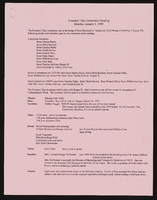Search the Special Collections and Archives Portal
Search Results
Carol C. Harter Professional Papers
Identifier
Abstract
The Carol C. Harter Professional Papers (1940-2023) consist of material documenting Harter's scholarly and administrative career. The collection includes letters, publications and reports, speeches, and photographs from Harter's time as the 11th and first female president of State University of New York (SUNY) Geneseo and as the 7th president of University of Nevada, Las Vegas (UNLV). As of 2024, Harter was UNLV's longest-serving and also its first female president.
Archival Collection
Gary Guy Wilson Architectural Drawings
Identifier
Abstract
The collection is comprised of drawings (1965-1996) completed by American architect Gary Guy Wilson and/or his architectural firm, Gary Guy Wilson, AIA, Architect Studios and contains 613 sets of drawings from over 250 different projects. Primarily focused on the Las Vegas, Nevada area, the materials feature hand-drawn architectural drawings, ranging from preliminary sketches to construction documents, and a number of printed computer aided drawings. The drawings also contain work from a number of consultants, engineers, and other architects who collaborated on the development of the various projects. The drawings include: commercial and professional buildings of varying scales, such as convenience stores, hotels, casinos, shopping centers, and office developments; schools; military buildings at both Nellis and Indian Springs Air Force Bases; multi-family residential developments; and custom single-family homes located throughout the Southwest (United States).
Archival Collection

Meeting minutes for Consolidated Student Senate University of Nevada, Las Vegas, March 13, 1986
Date
Archival Collection
Description
Text

Meeting minutes for Consolidated Student Senate, University of Nevada, Las Vegas, April 29, 1980
Date
Archival Collection
Description
Text

Alpha Kappa Alpha Sorority, Theta Theta Omega Chapter Founders Day committee reports
Date
Archival Collection
Description
From the Alpha Kappa Alpha Sorority, Incorporated, Theta Theta Omega Chapter Records (MS-01014) -- Chapter records file.
Text
LaVerne Ligon, B. J. Thomas, and Leonard Polk oral history interview: audio clip
Date
Archival Collection
Description
LaVerne Ligon discusses auditioning for the show Hallelujah Hollywood at the new MGM. She auditioned for Bob Mackie and Donn Arden, who wanted her to be topless in the show. She refused. Three weeks later, Donn Arden called her and said that she had changed his mind and he really wanted her in the show and she didn't have to go topless. In fact the entire line of Black dancers that he was putting together for the show did not have to go topless.
Sound
McMillan, James B., 1917-1999
Civil rights leader James B. McMillan was born in 1917 in Aberdeen, Mississippi and moved to Michigan in 1931 with his family. He finished his high school education in Hamtramck, Michigan where he was the first African-American captain of the football and track teams. In 1936, he opted to enroll at the University of Detroit rather than the segregated University of Michigan. After graduation, he moved to Nashville, Tennessee to attend Meharry Medical College School of Dentistry.
Person
Gregory, Matt, 1921-2000
Las Vegas, Nevada producer, manager, and agent Matthias Gregory Gluchowski (a.k.a. Matt Gregory) was born November 21, 1921 in Araucaria, Parana, Brazil. He was the son of an aristocratic Polish diplomat serving as Ambassador to Brazil. Matthias was raised in southern Poland on a large estate that bordered Czechoslovakia. He was educated at the Marian Fathers Lyceum in Warsaw, Poland, and later came to New York during his father's tenure as diplomat to the United States.
Person
Foley, Roger Drummond, 1917-1996
Roger Drummond Foley (1917-1996) was Nevada’s 23rd Attorney General and was nominated to the federal United States District Court, District of Nevada by President John F. Kennedy in 1962. A few of Foley’s famous cases during his tenure included the radiation exposure of the “Baneberry” Nuclear Test and the protection of the Ash Meadows Desert Pupfish in United States v. Francis Leo Cappaert.
Person
Ronzone, Richard James, 1917-1989
Richard “Dick” J. Ronzone (1917-1989) was active in the local politics and civic affairs of Las Vegas, Nevada, serving as a Clark County Commissioner, a Nevada State Assemblyman, and a member of the University Board of Regents. He inherited and managed his family's retail store which dated back to the early 1900s. Ronzone also helped develop the Municipal Golf Course and was active in the Elks Lodge, Rotary Club, Veterans Of Foreign Wars, Reserve Officers Association, and the Boulder Dam Area Council of the Boy Scouts of America.
Person
